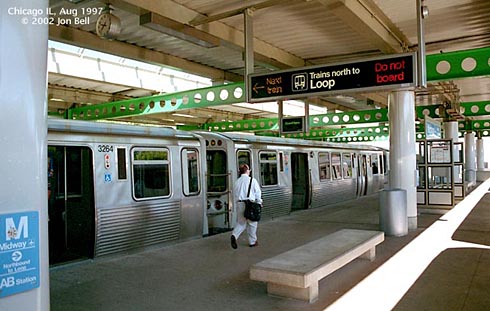
This view of the Midway
terminal from August 1997 shows cars 3263-3264 and 3239-3240
loading passengers for the trip to the Loop. As the overhead
sign denotes, trains load for the city on the east side and
trains unload from the city on the west. (This sign and
another identical one were removed in 2002 and replaced with
prototype ATSS signs.) As this is the end of the Orange Line
(for now), obviously you may not board the trains on the
west side. For a larger view, click here.
(Photo by Jon Bell).
|
Midway
(4600W/5900S)
59th Street and Kilpatrick
Avenue, West Elsdon
Service
Notes:

|
Orange Line:
Midway
|

|
Accessible
Station
|

|
Midway
Airport
|

|
Park'n'Ride: 299
spaces
|
Quick Facts:
Address: 4612 W. 59th
Street
Established: October 31, 1993
Original Line: n/a
Previous Names: none
|
Skip-Stop Type:
|

|
Station
|
Rebuilt: n/a
Status: In Use
History:
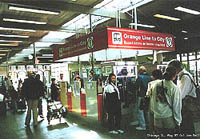
Passengers
figure out how to purchase their TransitCards (the Orange
Line was the first to utilize these) inside the Midway
Terminal in August 1997. Although AVMs have been installed,
note that there is a customer service counter under the
awning. Today, the overhead sign remains, but with the
removal of the information desk the "?" on it is an
anachronism. For a larger view, click here.
(Photo by Jon Bell) |
Southwest Chicago has long been neglected by rapid transit. The
Douglas Branch of the Metropolitan "L" served what was then the
southwest side in 1895, but the city soon grew far south of 22nd
Street and west of the South Side "L"'s tracks, leaving a significant
quadrant of the city unserved. In the 1940s, when the State Street and Dearborn Street subways were being constructed, the city planned
an elaborate system of subways to expand the "L" system, including a
southwest route from the Loop to Midway Airport. (See proposed
subway map.)
Unfortunately, the citizens of this area would have to wait
another fifty years before rapid transit would reach them, and then
was on an "L", not in a subway. In 1993, the
CTA completed the new Orange
Line, built inexpensively (about $500 million) using old abandoned
railroad rights-of-ways, including those previously used by the
Illinois Central Railroad, Santa Fe Railway and the Belt Railway of
Chicago. Interestingly, the
CTA chose not to utilize the
median of the Stevenson Expressway to carry the "L", built wide like
the Congress, Dan Ryan and Kennedy Expressways specifically to carry
rapid transit lines. This may have been for the best: putting an "L"
line in the median of an expressway isolates it from the neighborhood
it's supposed to serve.
Ground was broken for the Midway station during a ceremony at the
station site on January 22, 1990 attended by Mayor Daley, and
CTA Acting Executive Director
Bernard Ford, Chicago public works commissioner David Williams, U.S.
Rep. William Lipinski (D-Chicago), other public officials. Designed
under the auspices of the City, the architects were encouraged to use
distinctive styles for the stations while conforming to a basic
uniform layout and footprint. The three-track Midway terminal is laid
out to accommodate interchange with several bus routes, a complete
yard and a car maintenance facility. The station features one island
platform on the east and an additional side platform on the west.
Both lead to an overhead sidewalk via elevators, escalators and
stairs that goes west to the fare control area and was connected to
the airport terminal by a 1,200-foot moving walkway.
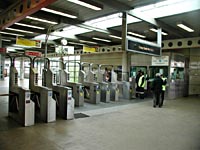
The interior
of Midway station is open and spacious, as seen looking
southeast at the fare controls on April 18, 2003. The long
row of turnstiles can handle a large volume of passengers
and several of the turnstiles (like a couple in the middle)
have wider clearances for easier navigation of luggage. For
a larger view, click here. (Photo by Graham
Garfield) |
The Midway station serves its namesake airport, originally
connected by a long elevated, enclosed skywalk with moving walkways
in both directions. Although this was a somewhat long walk, it was
safe and protected from the elements, and the moving belts made the
trip a bit less onerous. Chicago is the only city in the United
States to have more than one airport connected to rapid transit. The
station is situated outside of the airport structure and the platform
is depressed below grade purposely to facilitate the planned
extension of this line south to the Ford City Shopping Center at 76th
and Cicero. (Interestingly, the vinyl roller sheet that the trains'
destination signs are printed on already include one for Ford City,
sometimes visible when a motorman puts on the wrong sign or the sign
mechanism malfunctions.)
The new 3200-series cars
were ordered in conjunction with this project, most of which are
assigned to this line. The Orange Line the first to use
single-crewman operations, now standard on the whole "L" system.
Changes and Improvements, Early 2000s
In 2002, Midway became part of the RTA's Active Transit Station
Signs (ATSS) project, becoming one of four project test sites. The
ATSS signs provide real-time transit and traffic information on a
demonstration basis. They display a countdown of the minutes until
the next departing train, travel times to the Loop, fare information,
service disruption or delay messages or any other number of messages
the CTA chooses to program
into the signs.
One of the interesting aspects of the O'Hare
and Midway ATSS signs is that the ones in the transit station look
like those at the other two test stations. But the signs in the
airport are designed to harmonize with the existing signage already
in the airport (which, coincidentally, are of a completely different
design at the two airports). The signs on the platforms are not
currently programmed to display the time until next train like the
other stations' signs, since the airport stations are at the end of
the line and there is usually a train waiting to depart. As
programmed, these merely take the place of the LED "Next Train" signs
that they replaced (seen in the photo at the top of the page), with
one side saying "Do No Board" and the other "Next Train" with arrows
pointing to the appropriate tracks. (Only the island platform at
Midway has ATSS signs, since the lay-up track platform doesn't
usually have put-outs.) At the station house, there is a two-sided
sign is positioned over the entrance from the bus terminal. The side
facing outward from the entrance will display the time until the next
departure, while the side facing toward the entrance will display
which bus routes are operating at the time.

At Midway station, two women
prepare to board an inbound Orange Line train with their
baggage, guided to the correct train by the overhead ATSS
sign on October 25, 2002. For a larger view, click
here.
(Photo by Graham Garfield)
|
At both airports, there are also signs posted in the passageways
leading to the station from the airport terminal, through the parking
garage that stands between the airport and the
CTA station. Both
airports also have ATSS signs in the baggage claim areas. These signs
are not programmed to give the time until the next departure, since
in many cases it would take so long to get from the airport to the
station that the next train probably would have left (plus, many
people can't accurately judge how long it will take them to get to
the station from the terminal anyway). Instead, they give the service
interval (how frequently the trains run), travel time to the city,
and display other CTA and travel information.
In Fall 2002, the Chicago Department of Aviation (DOA) solving a
long-standing problem at Midway station, caused when the new airport
terminal and parking garage were built on the east side of Cicero and
the original elevated walkway that connected the station and the
airport was bisected. As originally built, the
CTA station was connected to
the airport terminal on the west side of Cicero Avenue by a long,
enclosed, elevated 1,200-foot skywalk. However, when the new airport
terminal and parking garage were built on the east side of Cicero,
the elevated walkway was cut off. As a result, only a short stretch
of the walkway remained and it fed directly into the parking garage,
which in turn fed into the new terminal. This was not, in and of
itself, a problem except that no provision was made in the parking
garage for a protected walkway for passengers walking between the
airport and the transit station. As a result, these luggage-toting
travelers were subjected to a confusing, poorly-marked walkway and
had to mingle dangerously with traffic in the garage. In Fall 2002,
the city DOA built an enclosed walkway between the terminal and where
the old walkway connects to the garage. Although travelers still have
to cross traffic lanes in 2-3 places (depending on which path you
take), the rest of the trip is now made in well-marked walkways
enclosed with clear, corrugated plexiglas partitions. Metal bumpers
protect the partitions from the outside in case an auto hits the wall
by accident. This provides a much more hospitable, friendly
connection between the airport and the transit station, making the
trip both safer and more inviting.
During Autumn 2004 and Spring 2005, several "L" stations got new
station name signs. As part of a multi-station program, twelve
facilities in all on the Blue, Purple, Red, Orange, and Green lines
received new, Green Line
Graphic Standard station name signs, replacing older KDR-type
signs that used an outdated graphic scheme that was inconsistent with
the colored line names. The new signs not only replaced old ones in
existing locations at these island platform stations, but were added
at additional locations outside the tracks, facing to the platform,
for ADA compliance. The new signs facing the east island platform
were mounted on new steel brackets that are supported and project
from the ground below. Installation at all stations was complete by
the end of November 2004. Fabrication and installation of the signs
was performed by contractor Western Remac.
Likewise, the original Modified
KDR graphics of the station's backlit entrance signs were
replaced with the newest Green Line
Graphic Standard variety, listing the station's name, in January
2006.
Kiss & Ride Closure, Reconstruction
In 2017, the City announced plans to expand the terminal garage, located immediately west of Midway Yard, as part of its Midway Modernization Program. The $143 million project included other improvements such as a new payment system, more automated gates, brighter LED lighting, new paint, and upgraded security cameras, elevators and directional signage. The expanded garage, adding 1,500 new parking spaces, would have been over a portion of the rail yard. The expansion plan required the demolition of the Midway station kiss & ride lot and temporary removal of tracks in Midway Yard. Construction began in July 2018.1
The kiss & ride drop-off/pick-up lot, adjacent to the stationhouse and bus terminal, temporarily closed at 7am, Saturday, August 4, 2018. A temporary kiss & ride lot was provided in the northeast corner of the park & ride lot, across the bus terminal from the station house.
However, although work had been underway for over a year, in fall 2019, the City cancelled the garage expansion plan. The project was shelved after the Chicago Department of Aviation (CDA) received updated cost projections that would have increased the price tag by at least $15 million. "After careful consideration of costs as well as industry trends, CDA determined the expansion was no longer viable, and the project was officially terminated in September, 2019," Aviation spokesman Matt McGrath said in a statement emailed to the Chicago Tribune. McGrath said the growth of ride-share services like Uber and Lyft meant fewer people were parking at the airport, adding that Midway terminal parking use fell by about 3.2% in 2018.2
By this time, however, the kiss & ride lot had been demolished and the yard tracks had been out of service for over a year. The community also expressed some concerns with the temporary kiss & ride setup, including during busy periods cars could not get into the shared park & ride/kiss & ride lot and would instead drop off their passengers along busy 59th Street, causing traffic backups and safety hazards; and some drivers exiting the lot onto 59th Street the wrong way, and then making U-turns. There were also complaints that it took an overly long time for the kiss & ride lot to be rebuilt and reopened after the garage project was cancelled.3
The rebuilt Midway kiss & ride lot reopened on Monday, January 6, 2020. According to CDA, the new kiss & ride area is an improvement over the old facility, using more durable concrete instead of asphalt, and with improved drainage.4
Station Artwork
In Summer 2006, Urban Gateways: Center for Arts Education, a
non-profit organization that provides multicultural performing,
visual and literary arts programs for children, teachers and parents
in the Chicago area, adopted the Midway station under the
CTA's Adopt-a-Station program.
As part of the adoption, artwork created by Chicago-area junior and
senior high school students was installed in the station mezzanine.
The artwork -- paintings which follow a time-focused theme and
include images of the Chicago skyline, jazz performers, dancers and
children next to clocks and use the airport as a backdrop for people
measuring their life by its arrivals and departures -- was created in
the summer of 2005 by junior high and high school students involved
in "Art Options", an Urban Gateways mentorship program designed to
enhance their professional art career development. The artwork
consists of 30 pieces, each painted on wood and mounted directly on
the station's orange ceiling beams in the mezzanine area over the
platforms. Each painting is approximately 24" x 34". Chicago Transit
Authority officials and Urban Gateways student artists and staff
dedicated the art on July 27, 2006 and recognized Urban Gateways for
their adoption of the Midway station.
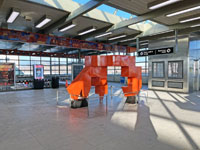
Space Junction of Energy, CTA's first commissioned art piece which was relocated to Midway in 2023, is seen on the station's mezzanine over the tracks on January 29, 2024. For a larger view,
click here. (Photo by Graham Garfield) |
In August 2023, a sculptural art installation was added to Midway station. Located in the paid area of the station on the mezzanine over the Orange Line tracks, the sculpture is new to Midway but not new to the CTA -- in fact, it was CTA's first permanent art installation.
The sculpture-in-steel
artwork, titled Space Junction of Energy, was created by Jerald Jacquard, who was an associate
professor of art at the Chicago Circle campus of the University of
Illinois. The piece was originally installed at Kimball in 1974 as part of the station's reconstruction, and provided the theme for
CTA's modernization of the
terminal. The sculpture was designed at the time with the specific site in mind, integrated with the system
of ramps and stairs that linked the station house with the platforms,
and was an excellent example of the successful integration of public
art with the design of a transit space. Said Jacquard at the opening ceremony, "It represents a paradox --
cubes through space. As one walks around the work, it becomes an
energizer for the mind." Space Junction of
Energy was the first specially-created artwork designed for and
installed in a CTA rail
station.
A subsequent renovation of Kimball station in 2006-07 required relocation of the Space Junction of Energy art sculpture.
CTA officials worked with
Jacquard to relocate the artwork on
CTA property. The artwork was reinstalled at Belmont, in a small plaza to the east of the historic station house at the north auxiliary entrance, circa 2009. The sculpture was removed from Belmont in 2022, again due to renovation construction work, this time for the Red and Purple Modernization (RPM) Phase One project.
Space Junction of Energy was moved to Midway by work train overnight August 1-2, 2023. The sculpture was lifted directly off the flatcar it arrived on using a crane; after a section of railing was temporarily removed, it was hoisted up to the mezzanine over the tracks. Once on the mezzanine, a mobile hoist was used to move it into place in the center the large open mezzanine over the tracks. After it was placed, a railing was installed around the sculpture to keep passengers from touching it, and an informational plaque provided.

The Midway Terminal is an
intermodal complex in every sense of the word. This view
looks northeast on April 18, 2003 from Kilpatrick Avenue
(less a street than a service drive). Visible on the right
is the bus terminal that no less than nine CTA and Pace bus
routes serve. The canopy on the left covers a walkway to a
kiss'n'ride and bike racks. Behind these canopies is the
rapid transit station. And above it all on the left is the
elevated walkway to the airport, where passengers can
transfer to points nationally and beyond! For a larger view,
click here.
(Photo by Graham Garfield)
|


|
midway02.jpg
(95k)
Another August 1997 view of the Midway terminal. Note that
the platforms are somewhat depressed below ground level.
This is to make it easier to extend the tracks beyond the
station. (Photo by Jon Bell)
|

|
midway04.jpg
(61k)
An Orange Line train on track 1 at the end of its run
discharges its passengers onto the Midway island platform,
looking south on May 6, 2001. (Photo by
Graham Garfield)
|
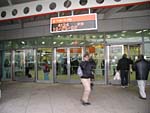
|
midway05.jpg
(138k)
The ATSS sign over the Midway station entrance from the bus
terminal sowed only the date and time on October 25, 2002,
but will eventually show departure information too.
(Photo by Graham Garfield)
|

|
midway07.jpg
(140k)
The Midway island platform, seen here looking north on
October 25, 2002, has ATSS signs at the bottom of the stairs
and other location, but the lay-up track on the left has
none. (Photo by Graham Garfield)
|

|
midway10.jpg
(155k)
As the ATSS sign counts down to its departure, car 3367 sits
in the middle of an Orange Line consist with its doors open,
ready to take passengers downtown or intermediate points on
the Southwest Side. The platform is tranquil in the
mid-afternoon of April 18, 2003, but teams with customers
during peak hours. (Photo by Graham
Garfield)
|
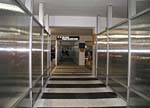
|
midway-GarageWalkway01.jpg
(125k)
Looking north in the new enclosed walkway in the Midway
Airport parking garage, between the terminal and the transit
station, on October 25, 2002. (Photo by
Graham Garfield)
|
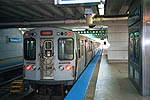
|
cta3304.jpg
(68k)
Car 3304 brings up the rear of an Orange Line train at
Midway on September 10, 2000. (Photo by
Ernie Baudler)
|

|
cta3204.jpg
(48k)
Car 3204 leads a two-car Orange Line train at Midway
Terminal, soon after operations began in late 1993.
(Photo by Eric Oszustowicz)
|

|
IRMtrip@Midway1.jpg
(67k)
The old and the new: 1993-built 3200-series
Orange Line car 3237 sits side-by-side with 1959-vintage
5-50 series car 22
at Midway Terminal at the
IRM PCC fantrip on May 6,
2001. (Photo by Graham Garfield)
|
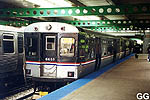
|
IRMtrip@Midway2.jpg
(63k)
Looking south at the three-car IRM
PCC charter train trailed by car 6655 at Midway
on May 6, 2001. (Photo by Graham
Garfield)
|

|
IRMtrip@Midway3.jpg
(75k)
The IRM PCC charter train,
with car 6655 bringing up the rear, is on the lay-up track
at Midway Terminal on May 6, 2001.
Car 6655 bears a 1950s/60s era Lake "A" route
sign. (Photo by
Graham Garfield)
|

|
cta3281.jpg
(72k)
Completing its run from the Loop, an Orange Line
train led by car 3281 pulls into Midway Terminal on Track 1,
looking north in July 1999. (Photo by Mike
Farrell)
|

|
cta6655d.jpg
(97k)
Car 6655, on the IRM's
PCC fan trip, has reached the end of the Orange Line at
Midway station on May 6, 2001. (Photo by
Mike Farrell)
|
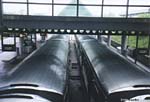
|
cta3200s@Midway2.jpg
(97k)
A view from atop the pedestrian bridge overlooking the
Midway terminal of the Orange Line
on May 8, 2002. The train of 3200s
on the left track is ready to head northwest to the Loop;
the train on the right has just returned from the
Loop. (Photo by Ernie Baudler)
|

|
cta3200s@Midway3.jpg
(104k)
Two 3200-series
cars stand side by side at the north end of Midway
terminal, looking west on May 8, 2002.
(Photo by Ernie Baudler)
|
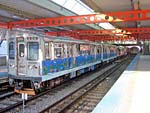
|
cta2894-holiday05a.jpg
(210k)
The CTA's Holiday
Train, a perennial favorite of Chicago children and adults
alike, is embellished a little more every year. Put together
with volunteer labor and staffed by volunteer
CTA employees, the
train travels to different lines throughout late November
and December each year. The 2005 Holiday Train is on a
layover at Midway terminal on
December 18, 2005. (Photo by Graham
Garfield)
|
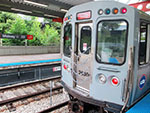 |
cta2636.jpg (304k)
Car 2636 is on the rear of an Orange Line train awaiting its departure time from Midway on July 2, 2014. A number of 2400-series cars have been assigned to Midway Yard since late 2012, both to support Orange Line trips added at that time as well as some Brown Line trips that are dispatched from Midway Yard. But as the 2400s were retired and more 5000-series cars were delivered, the 2600-series cars were displaced from the Red Line and reassigned to backfill the retired 2400s at Midway. (Photo by Corey Ellison) |
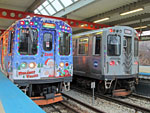 |
cta2898-HolidayTrain2014a.jpg (282k)
The CTA Holiday Train provides a decidedly more festive appearance than its regular-service counterpart while both await their next departures at Midway in early December 2014. (Photo by
Corey Ellison) |
 |
cta2894-HolidayTrain2015c.jpg (269k)
CTA's festively-decorated Christmas-season train sits on the side track at Midway terminal between trips on December 3, 2015. As the train was corporately-sponsored for the first time in 2015, the train was officially the "Sprint CTA Holiday Train" -- note the Sprint logo on the side under the center window, and the message along the letterboard over the windows. CTA received $300,000 from Sprint, one of the nation's largest mobile carriers. The sponsorship not only covered all of the 2015 operational costs for the train (and its counterpart, the Holiday Bus), it allowed CTA to add an extra day of service for the holiday train. (Photo by
Corey Ellison) |
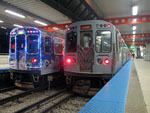 |
cta2880-2894-HolidayTrain2015.jpg (227k)
The Holiday Train sits next to car 2880 on the end of an Orange Line road train at Midway station on December 3, 2015. Although their commonalities are somewhat disguised by the graphically-intense wrap and bright lights festooned on the exterior, the Holiday Train cars and car 2880 are identical, both being 2600-series cars. Although long associated with the 3200-series cars, which opened the line in 1993 and were exclusively outfitted the line for many years, the Orange Line began to also run 2600s in 2012 when additional cars were needed to operate additional service that was added. (Photo by
Corey Ellison) |
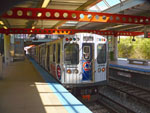 |
cta5303-Cubs01.jpg (261k)
On a brief layover during a charter trip, car 5303 is at one end of the four-car Cubs World Series-wrapped train on the side (layup) track at Midway station on April 23, 2017. (Photo by David Harrison) |

|
midway_20240129b.jpg (217k)
The art sculpture Space Junction of Energy, CTA's first commissioned art piece in 1974, originally at Kimball station, then relocated to Belmont and finally to Midway in 2023, is seen at the latter on January 29, 2024, in its new home on the mezzanine over the terminal tracks and train platforms. (Photo by Graham Garfield) |

- OrangeLineIntro.wav
(641k): BONUS TRACK! The full Orange Line intro
prerecorded announcement: "This is an Orange Line train to
downtown. Maps are posted in each railcar and station to help you
plan your trip--contact station personnel for further assistance.
Scheduled travel time to downtown is about 25 minutes. Welcome
aboard Orange Line run 705. Pulaski is next. In the
direction of travel, doors open on the left at
Pulaski." (Sound
courtesy of Tony Coppoletta)
.
- OrangeToMidway.wav
(76k): Automated announcement: "This is an Orange Line
train to Midway"
(Sound courtesy of Tony
Coppoletta)
.
- Midway.wav
(165k): This is Midway, as far as this train goes. All
passengers must leave the train."
(Sound courtesy of Tony Coppoletta)
Notes:
1. Wisniewski, Mary. "The Midway Airport kiss and ride lot has reopened -- 18 months after it was demolished for a garage expansion that never happened." Chicago Tribune, January 6, 2020.
2. Ibid.
3. Ibid.
4. Ibid.






























